The CDC has changed its isolation guidelines.
Previously, if you tested positive for Covid, you needed to isolate for ten days. Now you only need to isolate for five. The official announcement is here.
Read-through first, with my reactions, then reactions from others.
Given what we currently know about COVID-19 and the Omicron variant, CDC is shortening the recommended time for isolation from 10 days for people with COVID-19 to 5 days, if asymptomatic, followed by 5 days of wearing a mask when around others. The change is motivated by science demonstrating that the majority of SARS-CoV-2 transmission occurs early in the course of illness, generally in the 1-2 days prior to onset of symptoms and the 2-3 days after. Therefore, people who test positive should isolate for 5 days and, if asymptomatic at that time, they may leave isolation if they can continue to mask for 5 days to minimize the risk of infecting others.
I mean, bullshit. This is most definitely not motivated primarily by science demonstrating a distribution of transmission. If it was, the guidelines would have changed when they learned about this, rather than exactly when the guidelines otherwise needed to change. Due to what else we know about Omicron.
What we know about the Omicron variant is that it is everywhere and spreading fast. What we know is that lots of people are getting sick at once. If we forced them to isolate for ten days, there wouldn’t be anyone to staff the hospitals, man the checkout counters, drive the trucks and fly the planes. To erase any remaining doubt, The Washington Post confirms this was the motivation.
So in the interest of making sure people could do those things, we’re shortening the period to five days. Understandable? Definitely. I can’t argue with it. I’m all for ‘following the economics.’ The isolation guidelines didn’t match the reality on the ground. They had to change to match reality.
But every time you say you are ‘following the science’ when you’re transparently not doing that on any level, you’re burning your credibility and the commons that much more. It needs to stop.
Timing things to the positive test rather than to the onset of symptoms or to the exposure makes sense, since it’s the only objective measurement to go by. That can’t really change. It’s interesting that this creates an extra incentive to test positive quickly if you’re going to test positive at all. Testing positive later in a way that can’t be backdated is a disaster. So either you want to avoid testing positive, or make sure it happens fast.
The five days of mask use (my true love told to me) are a fig leaf that will please no one. It will have little effect, because those who would listen to such a request would always have worn a mask, while those who would be inclined to ignore it are going to ignore it.
Note the lack of a requirement of a negative test of any kind. A PCR test isn’t an option because such tests stay positive for longer than five days, but a rapid test is for exactly this situation. It measures whether you’re infectious or not.
Onward:
Additionally, CDC is updating the recommended quarantine period for those exposed to COVID-19. For people who are unvaccinated or are more than six months out from their second mRNA dose (or more than 2 months after the J&J vaccine) and not yet boosted, CDC now recommends quarantine for 5 days followed by strict mask use for an additional 5 days. Alternatively, if a 5-day quarantine is not feasible, it is imperative that an exposed person wear a well-fitting mask at all times when around others for 10 days after exposure. Individuals who have received their booster shot do not need to quarantine following an exposure, but should wear a mask for 10 days after the exposure. For all those exposed, best practice would also include a test for SARS-CoV-2 at day 5 after exposure. If symptoms occur, individuals should immediately quarantine until a negative test confirms symptoms are not attributable to COVID-19.
If you’re not boosted, you’re treated as unvaccinated for purposes of spread under Omicron. That makes perfect sense. You might be safer yourself, but you’re not that much less likely to spread Omicron.
Again, the five days of mask use (six feet apart) seem like a fig leaf, although somehow a marginally more likely one to have a nonzero effect.
The test at five days after exposure is rather silly given Omicron’s pattern, and way too late given the quarantine requirement. I’d be testing on more like day three if I had an exposure I was taking actually seriously, or two and four if I was testing twice. Five is presumably picked here entirely for Law of Five reasons. It seems to completely contradict the five day period earlier. If generation time is two to three days, and most exposure is in the first five days, what does testing after five days accomplish? Especially if it’s PCR, so you take another day for it to come back?
Isolation relates to behavior after a confirmed infection. Isolation for 5 days followed by wearing a well-fitting mask will minimize the risk of spreading the virus to others. Quarantine refers to the time following exposure to the virus or close contact with someone known to have COVID-19. Both updates come as the Omicron variant continues to spread throughout the U.S. and reflects the current science on when and for how long a person is maximally infectious.
I do not understand this distinction. Isolation and quarantine are the same thing and using two words to make them seem like different things is confusing. If you didn’t know already, how confident would you be which was which? I’d be a pure coin flip. By using different names, the CDC is trying to pretend that they don’t have to contend with the same physical action in a consistent physical universe.
Data from South Africa and the United Kingdom demonstrate that vaccine effectiveness against infection for two doses of an mRNA vaccine is approximately 35%. A COVID-19 vaccine booster dose restores vaccine effectiveness against infection to 75%. COVID-19 vaccination decreases the risk of severe disease, hospitalization, and death from COVID-19. CDC strongly encourages COVID-19 vaccination for everyone 5 and older and boosters for everyone 16 and older. Vaccination is the best way to protect yourself and reduce the impact of COVID-19 on our communities.
These protection estimates are stated way too confidently. We have our guesses, and these are not insane point estimates, but they’re guesses and this is stating them as facts. Now, when the best guesses change, what does the CDC do to its facts? Once again, presumably the old numbers will get stuck to for too long, then the change will cause everyone to complain, and the cycle continues. I broadly agree with the 75% guess, but the 35% guess seems like the result of soldier mindset and choosing the highest plausible result so as to not cause people to lose faith in vaccinations.
The word ‘restores’ here is a cute touch.
The following is attributable to CDC Director, Dr. Rochelle Walensky:
“The Omicron variant is spreading quickly and has the potential to impact all facets of our society. CDC’s updated recommendations for isolation and quarantine balance what we know about the spread of the virus and the protection provided by vaccination and booster doses. These updates ensure people can safely continue their daily lives. Prevention is our best option: get vaccinated, get boosted, wear a mask in public indoor settings in areas of substantial and high community transmission, and take a test before you gather.”
The continued emphasis on prevention with no attention paid to mitigation and treatment, which makes sense under a contain-the-pandemic model but not under Omicron.
My overall take is that this is a clear improvement over the old rules, but clearly not optimal. The extra mask wearing will be ignored, whereas requiring a negative rapid test would have been better, and gone over better. I don’t understand how you get to a point where testing isn’t required here. But something had to change. The old rules were not workable.
I am sad that they could not admit they were doing this for practical reasons, and that they felt the need to be so overconfident in their statements, but the CDC has a strong longstanding principled opposition to practical considerations of all kinds, and it would be quite the scandal if they were seen doing things in order to make people’s lives better at the expense of the demands of ‘public health.’
Here’s their chart:
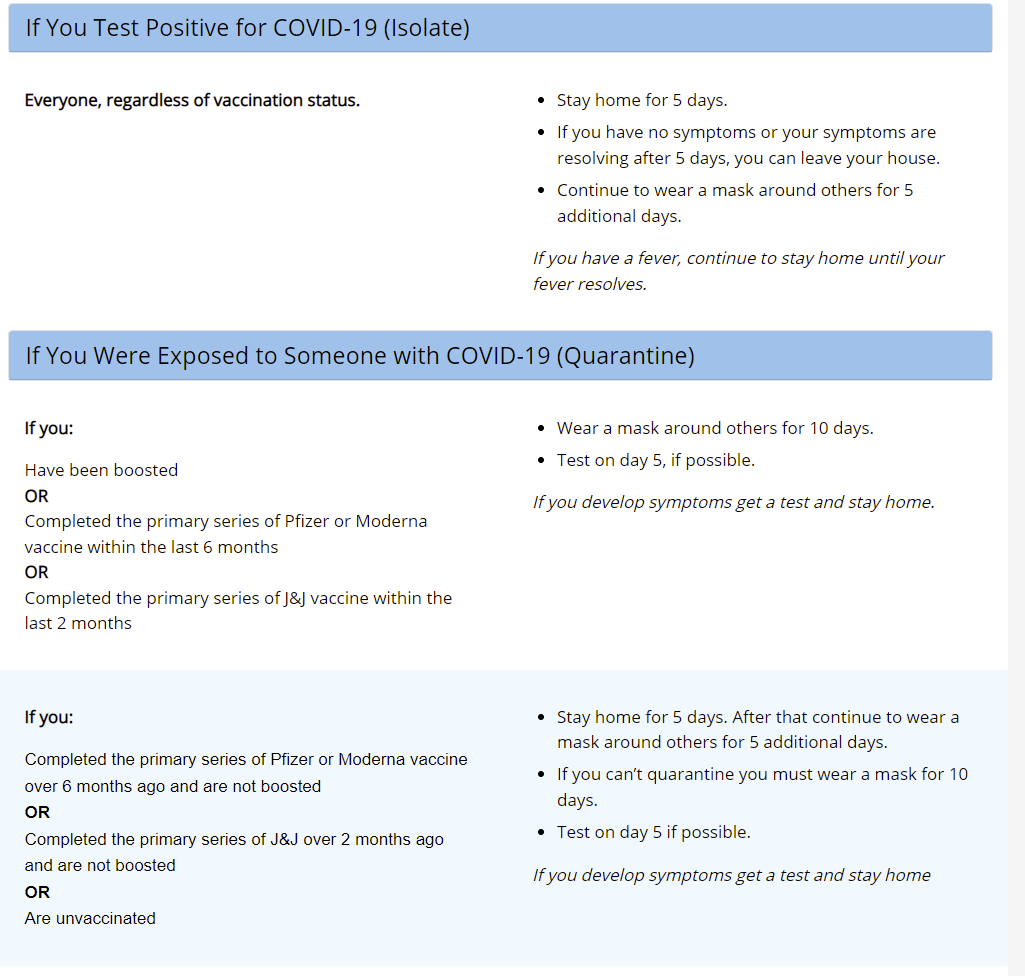
I didn’t look carefully at the chart on first review, so I didn’t notice the ‘or your symptoms are resolving’ clause here, which will get discussed below and that seems bizarre and troubling. As far as I can tell this remains unclarified.
Here’s Helen Branswell covering the change, highlighting the important content, as an alternative summary.




Reactions
So you can guess what people’s reactions largely were. No one was fooled.
As usual, these rules are the standard ‘get out of blame free’ fallback positions, and they tend to become default actions. They definitely matter.
The ‘Symptoms Are Resolving’ Language
There’s this weird thing in the CDC guidelines where it says if your symptoms ‘are resolving’ that I didn’t notice at first, but yes, this is kind of weird.
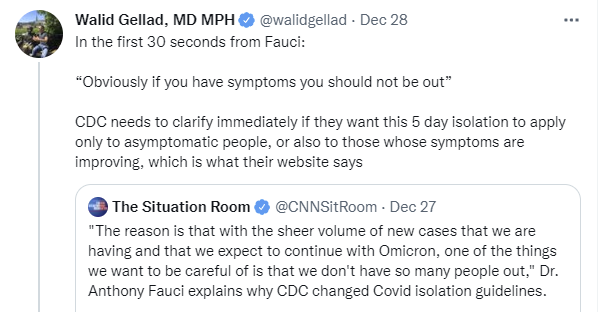
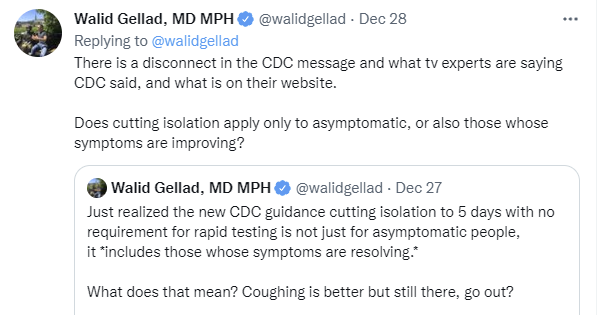
I have no idea what this means either. What does it mean for something to be ‘resolving’? If it does actually mean ‘symptoms are improving but not gone’ then that doesn’t seem great.
The Lack of a Required Rapid Test
Here was the CDC’s explicit reasoning on not requiring a test, quote from the Washington Post article:
Walensky said the agency decided not to require a negative test result after people had isolated for five days because the results are often inaccurateat that point in an infection. PCR tests — those typically performed in a lab which are around 98 percent effective — can show positive results long after a person is no longer infectious because of the presence of viral remnants,she said. It remains unclear how well rapid, at-home tests determine someone’s ability to transmit the virus in the latter part of their infection, she added.
This is standard government thinking. We can’t use PCR for the sensible reason that it will stay positive long after infectiousness. We can’t use rapid tests because we don’t know how accurate they are in this particular situation, so instead we’re going to (1) not run experiments to find out, experiments remain illegal and (2) instead not run any tests at all, which is known to be about 50% accurate. I call heads.
I saw a lot of objections to the lack of a testing requirement in particular. Which makes sense, since it’s the part of the recommendation that seems clearly wrong.
Thread continues after this but you get the idea.
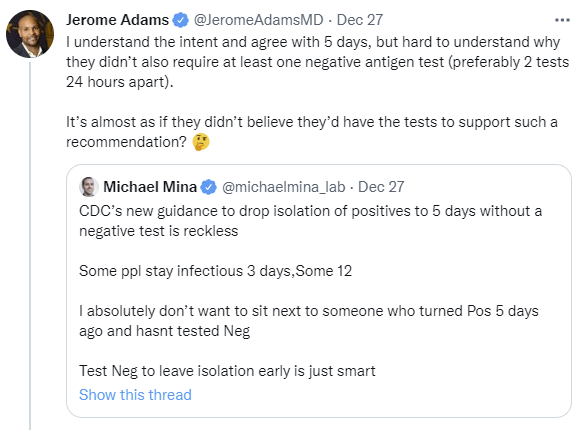
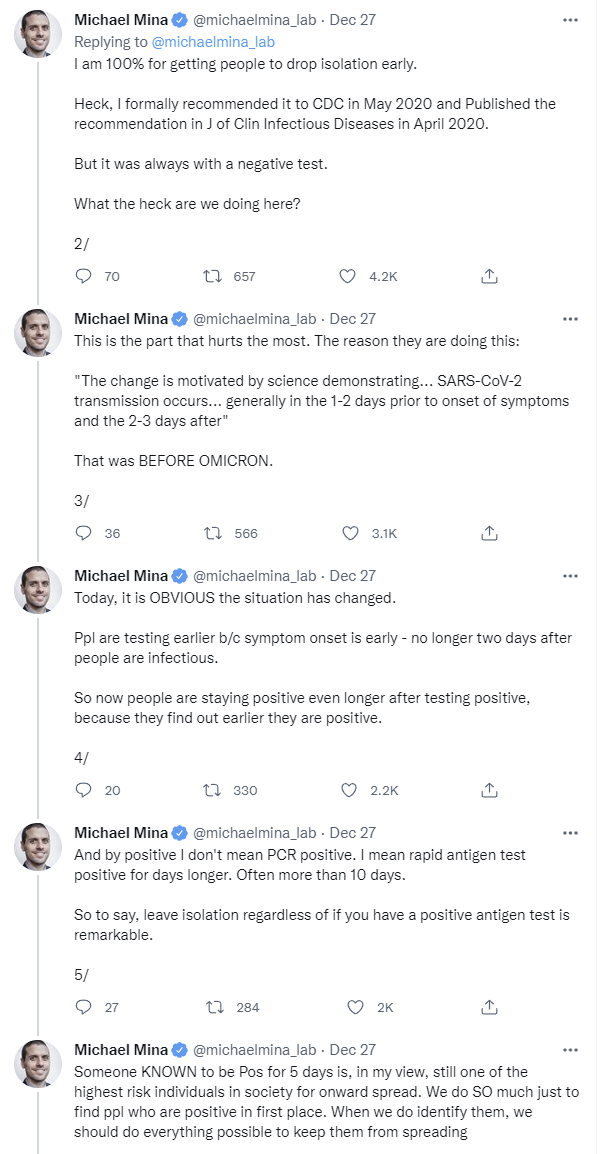
In case it wasn’t fully obvious, Mina strongly disagrees with the suggestion that rapid tests wouldn’t be accurate here. That’s what they’re for and this ‘we don’t know how effective they are’ line doesn’t seem true in any relevant way.
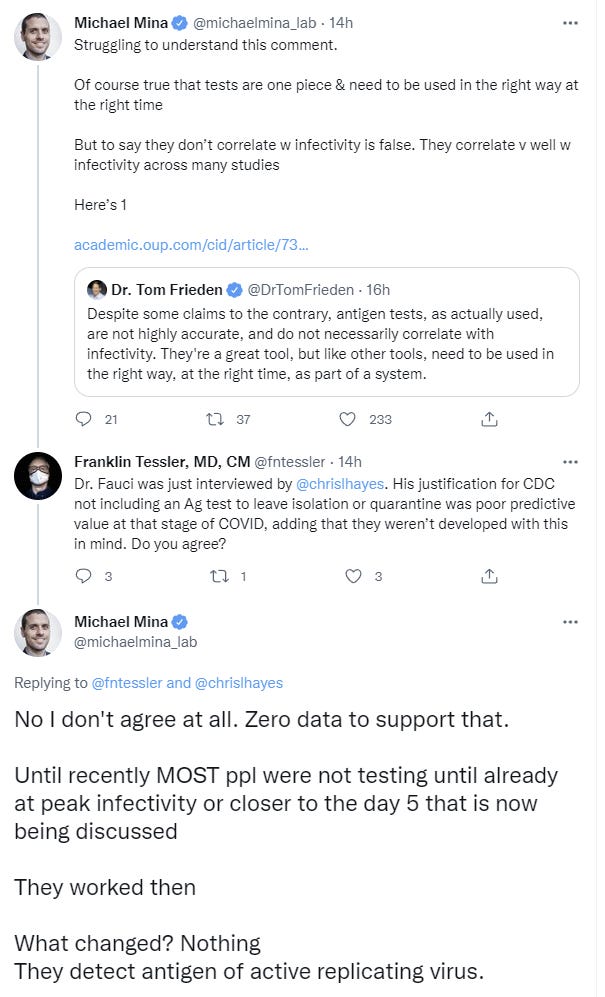
A personal anecdote from one of our usual sources:

A similar bafflement on how we could not be asking for a negative test.
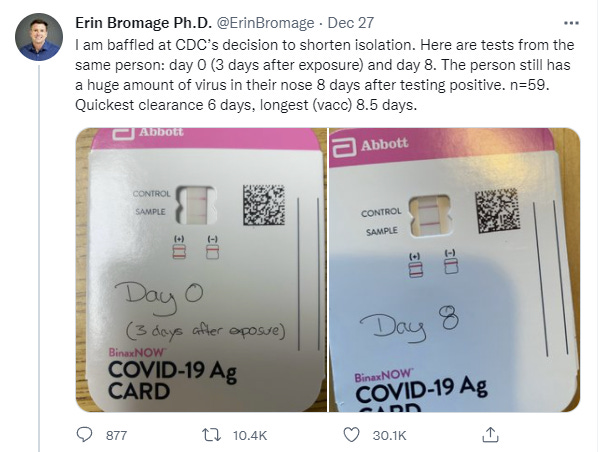

The trade-off decisions here definitely seem wrong, and this seems apt:

He goes on to explain in detail.

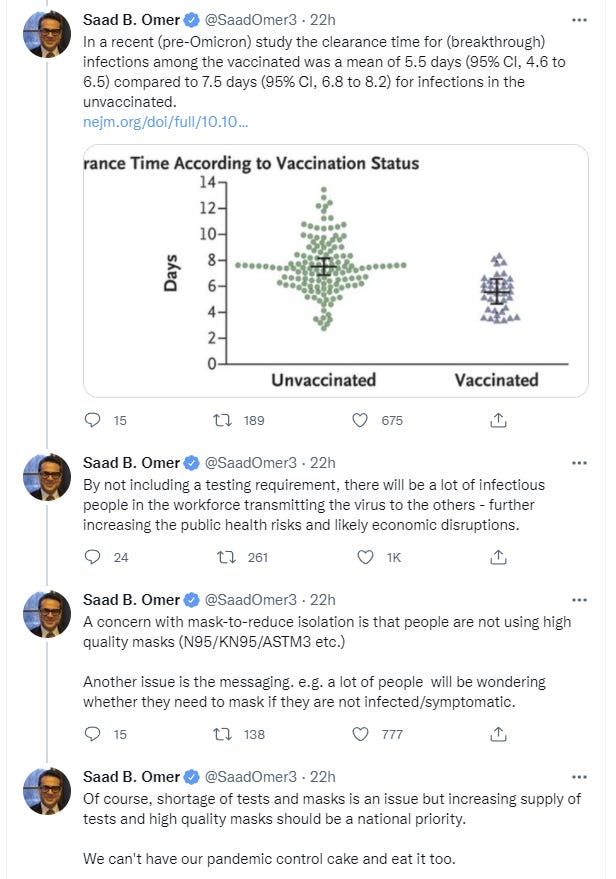
That last statement is the one that irks. Of course we can have cake and eat it too. All we have to do it bake more cakes. Then some cake gets eaten, and some cake you still have. Instead, we keep refusing to allow unapproved cake baking, and we’re confused that we’re out of cakes. But there’s no morality play here, there’s only an avoidable cake shortage. Let us bake cakes. And then let us eat it.
The CDC is using the logic of probability and cost-benefit analysis. They’re saying that after 5 days the cost of isolation exceeds the benefits. The responses are wisely saying ‘you could reduce costs on the cheap by adding in a test’ but they’re also saying ‘you didn’t reduce costs to zero, therefore the policy makes no sense’ and that doesn’t engage with the actual situation:
“There are people who are infectious and can transmit after five days,” said Walid Gellad, professor of medicine at the University of Pittsburgh. “It’s probably not the majority, but there are people, so by doing this, you are in effect encouraging people to engage in activities that could increase transmission.
The Standard ‘Health-Only’ Lines Rant Section
The ‘you didn’t reduce costs to zero’ and ‘only health considerations count’ logics, as always, are the standard procedure of many ‘experts.’ Eric Feigl-Ding continues to be the exemplar of one-track health-only thinking, where it’s crazy that anyone would care about anything else, and everything always calls for the same actions without regard to a physical model. I figured I’d break down his thread as the example here.
Skip the section if you don’t need it, I felt somewhat dirty writing it, but for those who need it, it’s good to have a breakdown of what’s going on with such arguments. One needs to know what the CDC is up against here, and the arguments that will be made when anyone making decisions cares about the well-being of people.
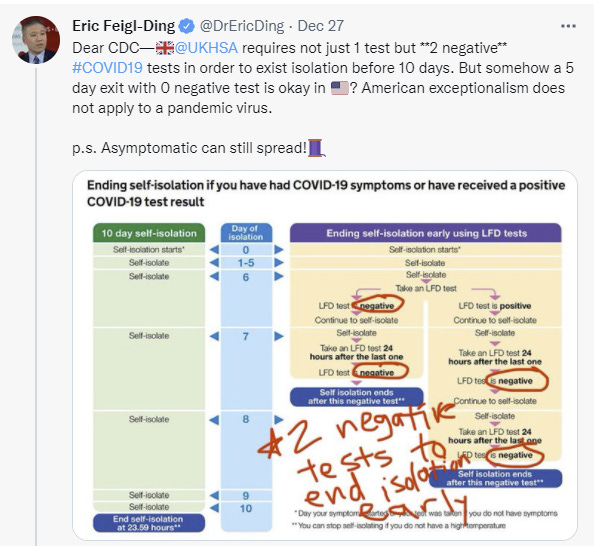
This is technically true, but clearly intended to mislead, by giving impression UK is 10 days plus test versus US being 5 days but no test. That’s not the case. The UK here is saying two negative tests lets you leave early. The CDC isn’t giving people that option, but should give people that option. So this is 5 days versus 7-10 days, depending on how the tests go.

‘Prolong the pandemic’ here gives the game away, because this will do the exact opposite of that.
If you have lots of cases quickly, that’s bad because it potentially overwhelms the hospitals. But it’s good in the sense that it makes things end faster. Not flattening the curve shortens the pandemic, flattening the curve prolongs it. Worsening transmission now has positive effects later. I don’t care about the ethical implications of it, that’s basic math. Ball don’t lie.
Instead, all good things are good and all bad things are bad, so of course something bad (‘lackadaisical’) must also be bad by prolonging the epidemic. And makes the hospital system crisis ‘longer,’ which it wouldn’t be, rather than the actual risk of making the crisis more acute.
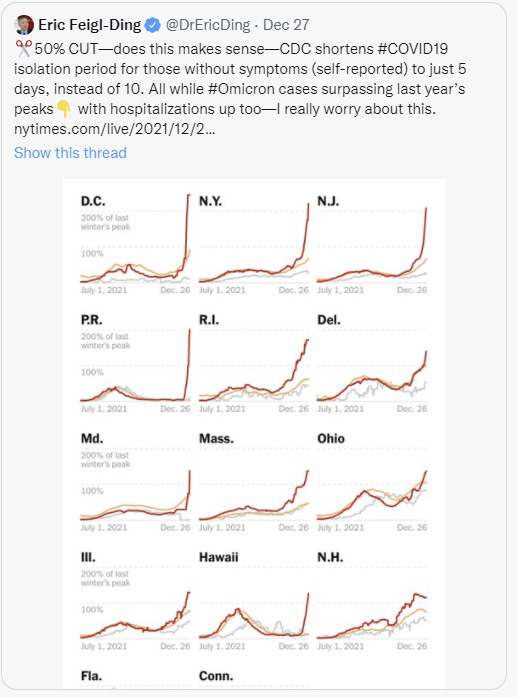
Yes, actually, it makes perfect sense. With this many cases we can’t afford long periods of isolation, that’s the whole point.
Also, a lot of the reason to isolate is to ‘stop the spread’ and have less people get infected. If you realize you can’t stop the spread and everyone who doesn’t take strong countermeasures is getting infected, the marginal effect of another potentially infectious person, rather than being an exponential multiplier, is marginal.
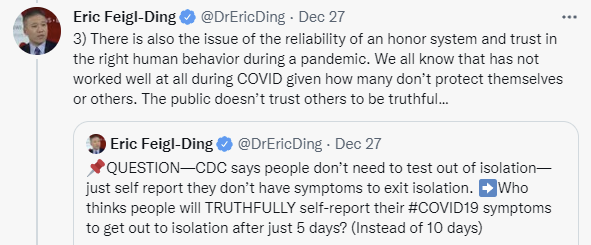
This type of thinking has profound contempt for citizens.

If you’re cosigning with Mina, does this mean that you’d be fine with 5 days conditional on a negative rapid test, when you just said you don’t trust citizens to not lie? I don’t believe you, at all.

Any time someone is talking about the risk to kids with Covid-19 you know they’re not scope sensitive. This is a dumb concern, and comes because the word ‘vigilant’ is written on the bottom of every page of the notebook in advance, to save time.
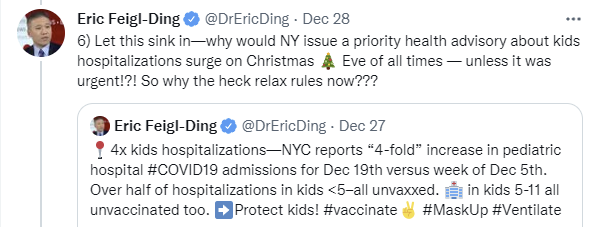
They’d issue the advisory because that’s the kind of thing such systems do in these spots. Advisories are free.
Next up, pure argument from authority.

This is not an even he thinks situation, it’s an of course he thinks situation. CDC thinking is ‘health-only’ thinking, and CDC epidemiologists are the most biased in favor of restrictions and against economic considerations. This isn’t evidence.

Yes, the lines of who is more trustworthy have indeed blurred, but when he says ‘trustworthy’ he means ‘is calling for the most vigilance’ regardless of the situation. That’s what trust means to this type of thinking, trust to carry the torch no matter the consequences.
In one way I sympathize, which is that in this model it is the CDC’s job to argue as an advocate for maximum action, like they were in a court of law as the Devil’s Advocate, while the executive branch and others who want to keep society running take the other side, and they hammer things out. The idea that the CDC would be ‘influenced’ by non-health considerations is anathema to this.
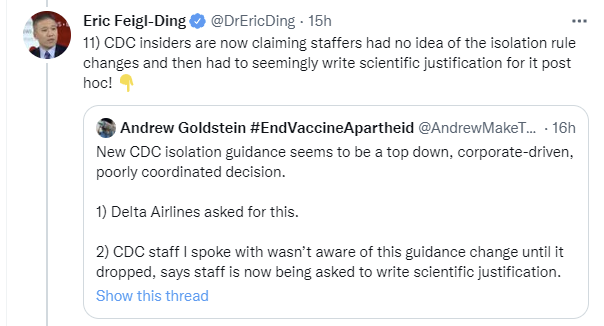
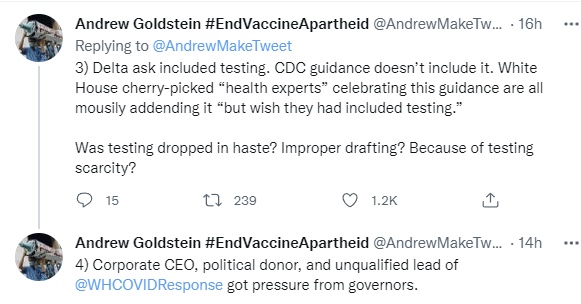
Delta asked for this and got it, so it’s political pressure, except that wasn’t political pressure, and also this wasn’t what Delta asked for it was far more permissive than that, so that makes it even worse?


I don’t see much of a causal link with Delta’s request, except insofar as there was an obvious similar need in many places.
And of course, an expert means someone who supports maximum restrictions, so anyone who doesn’t is now instead a cherry-picked “health expert.”
Skipping some because parts it descends into pure mockery.
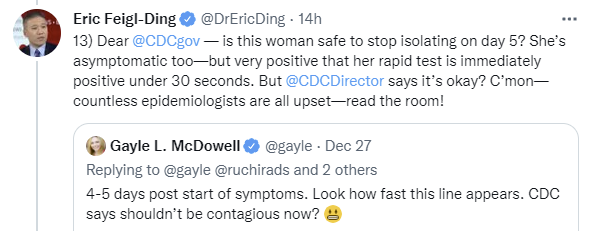
CDC is saying that the bulk of contagiousness happens within five days, that’s not a contradiction with some people remaining contagious. If such ‘experts’ can’t understand such basic logic, no wonder they think regular people can’t handle reality.
Finally, he stands with the flight attendants claiming that this is all about ‘economic considerations.’ Which, yes, it is, and can we please stop acting like they don’t matter.
The New Guidance Is Different Than The Old Guidance
When the facts change, I change my mind. What do you do, sir?
Why, point out that you changed your mind, and that’s terrible.


Admittedly, a bunch of the ‘The CDC now says’ jokes were pretty funny (this collection is medicore though).
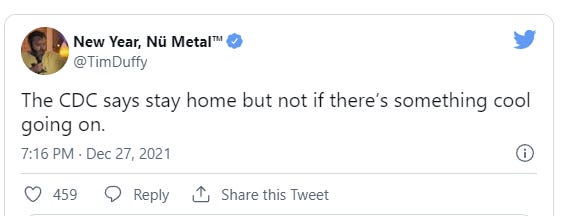
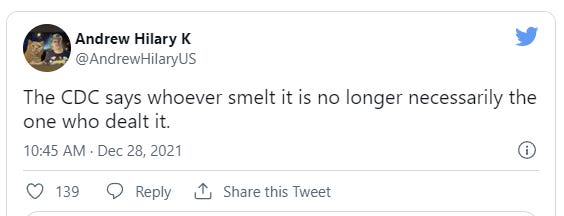
The CDC is now, in this perspective, like a box of chocolates.

The fundamental problem continues to be the mindset that the CDC is supposed to take a stupid unbalanced position in favor of absurd Sacrifices to the Gods, and then we’re supposed to say ‘that’s nice, dear’ and compromise between that and other considerations, rather than the CDC doing something reasonable. Which results in statements like this resonating with people.
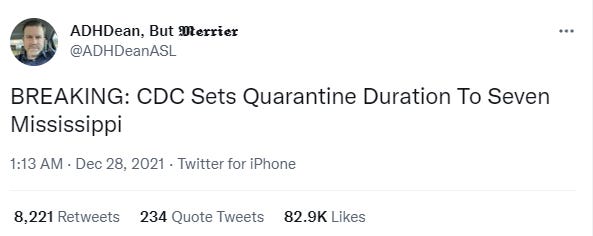

Thus, many people kind of actually believe this:

If your job is to decide what maximum caution is, and make that the requirement, then yes you can only err on the side of incaution.
What’s weird is to see this, at the end of the day:

Which seems exactly right. Some amount of transmission is inevitable, and we make trade-offs. That doesn’t mean that you can’t make different trade-offs with the people you care about, or adapt your actions to different situations. Would I go out to the grocery store five days after my positive test if I have a negative one? Maybe. Would I go to grandma’s house? Absolutely not.
People Will Ignore Your Guidance So It’s Your Fault For Not Giving Everyone Stricter Guidance
The title points out how this could be seen as rather silly, but it’s a real issue.
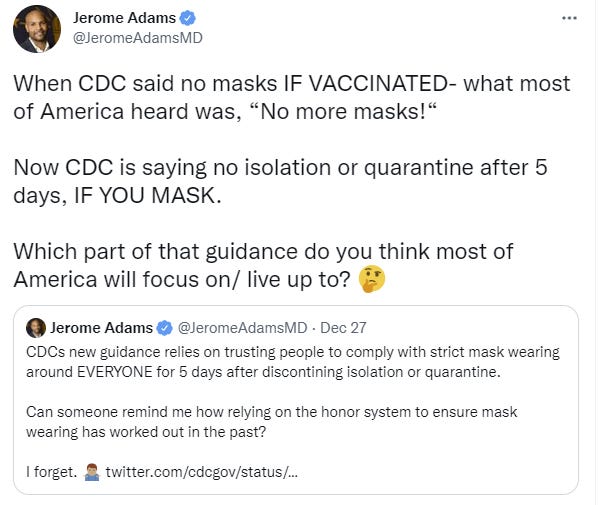
Will the same logic that applied there also apply here? As I noted above, I think the answer is mostly yes. I simply don’t care, because I don’t think the mask requirement was ever going to do much work. To extent it’s being called out as a fig leaf, I can’t argue with that. But it certainly can help employers require the masking, for example, so it’s good that it was included on reflection.
If Things Are So Bad That You Can’t Afford These Sacrifices to the Gods, Why Aren’t You Sacrificing More to the Gods?
As in, if we have so many sick that we can’t isolate, maybe we should be doing more social distancing?

There’s various forms of contradictions running around, some of which are illusory, some of which are backwards.
Yes, all of this was obvious. And a lot of us didn’t go about our normal holiday business, instead making various adjustments from more testing to more distancing in advance of the gatherings up to full cancellation. What the government didn’t do was call for people to cancel Christmas.
And yes, we could have told people to give up relatively high-value interactions in the name of slowing down the spread, but the whole idea is that stopping this is not a real option, so we should do our best to muddle through.
The very idea of not stopping such things doesn’t parse to a certain kind of ‘expert.’
That doesn’t mean the point is entirely invalid. If we knew that as a result of the spread plus these additional guidelines, the hospitals were about to collapse, then there’s a valid complaint that not previously taking steps was an error, but that’s hindsight rather than a reason to act differently now.
Also good to remember that the CDC is not ‘the government’ and they don’t act as a unified whole. Others telling you to go about your normal business, then getting the CDC to go along with doing normal business harder when things get tricky, is neither a contradiction nor surprising.
I applaud letting private individuals make the decision as often as possible on when to do prevention and when it’s not worth doing prevention.
Washington Post Roundup
The Washington Post article linked above centers criticism at ‘experts’ and also union leaders. They do not like this, because their workers are being asked to come in and do work to keep things running. Business leaders did like it, for exactly the same reason.
The guidance suggesting those with no symptoms or whose symptoms are resolving may cut their isolation time from 10 days to five and then mask for an additional five days has been criticized by someexperts and union leaders, who say it is based more on economic, than health, considerations.
Economic considerations are real considerations, hence the need to talk price, and it’s good to finally see decisions made on the basis of what’s actually at stake. But people strongly dislike it.
There then follows a trio of objections. Note the word ‘only’ in the next quote, implicitly denying that there are tradeoffs.
“It’s only going to lead to more illness, more cases,” Jean Ross, president of National Nurses United, said during an appearance on CNN.
Also note the standard logic of ‘big business likes this therefore you know it’s bad.’
Sara Nelson, president of the Association of Flight Attendants, said she is concerned the guidance is so closely aligned with the requests of business leaders.
Finally, object that a guideline will cause people to explicitly violate that guideline, and that violation would be bad, so the guidelines need to be even stricter to prevent such violations? Except the chart has something weird in it, so maybe Nelson is right here.
“No worker should be forced to come to work when they’re still sick,” Nelson said on CNN. “We’re very concerned about that.”
When you’re talking about ‘forcing a worker to come to work while sick’ this is about them wanting to stay home and get better, and you telling them no, I don’t care how bad you feel, come in or else, which is not what this is.
There is a longstanding problem in America where workers are effectively forced to come into work while actively sick, that has existed long before Covid-19. This is a bad norm, people should not (except in emergencies) be forced to come into work sick. I’ve been fortunate that every job I’ve had has recognized this and told us to stay home if we were sick, but others are less fortunate.
Thing is, the CDC’s text didn’t say that. They’re saying you still need to be symptom-free, which under normal circumstances is the definition of ‘no longer sick.’
But then the chart says ‘symptoms improving’ and this could easily give employers the green light to do exactly this, and force symptomatic people to return to work. My presumption is that this will be rare. If someone says ‘I still have symptoms’ and you believe them, you’d have to be pretty crazy or very desperate to have them come in, since you’re giving yourself a ticket to more trouble a few days later. But people are stupid, and if you think your whole workforce is getting Omicron anyway, maybe you don’t care.
The business leaders, of course, are happy.
The guidelines could offer relief to airlines, which began preemptively canceling flights before Christmas as coronavirus cases spiked among their crews. Carriers had lobbied the CDC for changes last week, arguing that it would be impossible to keep planes in the air with so many employees out with infections.
The airline industry group Airlines for America hailed the decision. “The aviation workforce is essential to maintaining the operations of air travel and cargo supply chains,” the group said in a statement.
Holly Wade, executive director of the National Federation of Independent Business, also applauded the decision, saying it could help alleviate workforce disruptions affecting many companies.
Health care workers are a special case, because there is now the sacred value of ‘health’ on both sides, and it’s obvious that one must compromise. Despite that, the explanation needs to hide behind a mask, claiming that they wear personal protective equipment so it’s fine. Let’s hear from someone directly in charge of a health system talking their book in this way.
Some health experts said they supported the updated quarantine and isolation guidelines for health-care workers, but did not know if they made sense for the rest of society. Health-care workers have to mask and wear personal protective equipment in the workplace, but that is not the case for millions of other Americans, said Lisa Maragakis, senior director of infection prevention for the Johns Hopkins Health System.
The CDC explicitly is requiring that same protective equipment for others, and there’s nothing stopping others from using it, and I notice this doesn’t seem to matter.